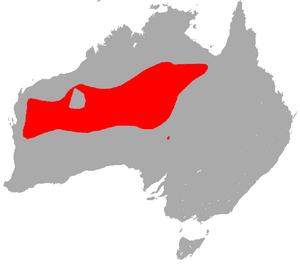Hill's sheath-tailed bat facts for kids
Quick facts for kids Hill's sheath-tailed bat |
|
|---|---|
| Conservation status | |
| Scientific classification | |
| Genus: |
Taphozous
|
| Species: |
hilli
|
 |
|
| Hill's tomb bat range | |
The Hill's sheath-tailed bat (Taphozous hilli) is a small bat that lives in the deserts of central Australia. It belongs to a family of bats called Emballonuridae, which are also known as sheath-tailed bats.
Contents
Discovering the Hill's Sheath-tailed Bat
This special bat was officially described in 1980 by a scientist named Darrell Kitchener. Before this, people thought these bats were a more common type called the Taphozous georgianus.
Kitchener named this new species after John Edwards Hill. Hill was another important bat scientist from the British Museum. He had helped Kitchener and studied Australian bats for many years.
The first Hill's sheath-tailed bat that scientists studied was a female. It was found in 1979 at a mine site near Mount Bruce. Scientists used a special net called a mistnet to catch her.
People sometimes call this bat the Hill's tomb bat or Hill's sheathtail bat.
What Does the Hill's Sheath-tailed Bat Look Like?
This bat is small and looks a bit like the common sheath-tailed bat. Its fur is dark brown on its back. The fur becomes a little lighter near its bottom. Its wing membranes are greyish-brown. The fur on its belly has an orange color with olive-brown tips.
Size and Weight
The length of its forearm, which is part of its wing, is usually between 63 and 72 millimeters. That's about 2.5 to 2.8 inches. On average, their forearms are about 67.7 mm long.
These bats weigh between 20 and 29 grams. That's about the same as four to six quarters! The average weight is 25.5 grams.
From its head to its body, the bat measures 65 to 81 mm long. Its ears are quite long, from 18 to 24 mm from the bottom to the tip.
Special Features
Male Hill's sheath-tailed bats have a special pouch on their throat called a gular pouch. Females also have this pouch, but it's not as developed. This pouch helps scientists tell them apart from other similar bats. These throat pouches contain special glands.
Where Do Hill's Sheath-tailed Bats Live?
The Hill's sheath-tailed bat is only found in Australia. Its home stretches from the dry northwest parts of Australia. It goes through the central deserts of the Northern Territory and into the northwest corner of South Australia.
These bats like to live in cracks in cliffs and in caves. They prefer dry areas in the middle and west of the continent. They often choose deep cracks in rocks near waterholes. Sometimes, they even share their roosts (resting places) in mines with the common sheath-tailed bat.
Life and Habits of the Bat
Habitat and Roosting
Hill's sheath-tailed bats live in the dry and semi-dry areas of western and central Australia. They are experts at living in desert environments. They have been seen in areas like the Murchison and Pilbara regions. They also live in the Gibson Desert and near Tennant Creek.
It is thought that these bats are quite common. Mining operations can sometimes create more places for them to roost. They will often move into a mine site soon after people leave. They can be found resting with the common sheath-tailed bat, Taphozous georgianus.
Diet
We don't know a lot about what these bats eat. But we do know they feed on insects. Their mouth parts are different from the common sheath-tailed bats they live with. This suggests they chew their food differently and might eat different types of insects.
Reproduction
Female Hill's sheath-tailed bats usually have one baby bat. This happens during the Australian summer and autumn.
During the breeding season, the male bat's special neck pouch gets bigger and deeper. Scientists think this gular pouch might have a social purpose, perhaps for attracting mates.
Conservation Status
The Hill's sheath-tailed bat is listed as 'least concern' in Queensland and the Northern Territory. This means their populations are stable and not at high risk. However, in South Australia, they are listed as 'rare' and 'near threatened'.
Some things that could harm these bats include losing their roosting sites. This can happen if their habitats are destroyed or damaged by mining. Changes in land use, like pastoralism (raising livestock) and farming, can also affect them.
The IUCN Red List (2008) also lists the species as 'least concern'. They note that there is no sign of their population decreasing.
See also
 In Spanish: Taphozous hilli para niños
In Spanish: Taphozous hilli para niños


